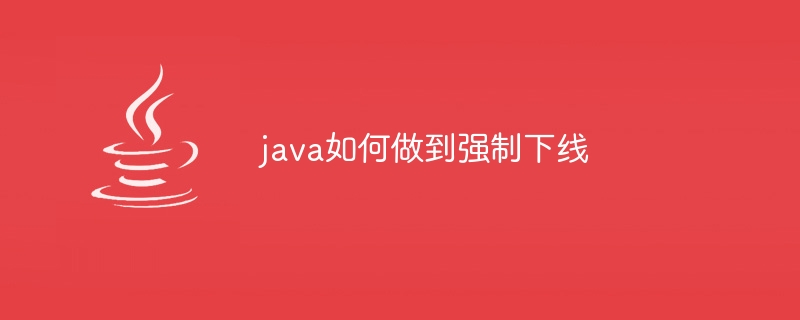java如何做到强制下线
- 小老鼠原创
- 2024-04-17 04:57:19907浏览
Java中实现强制下线的方式:1. 定义继承 Remote 接口的远程接口;2. 创建实现远程接口的类并继承 UnicastRemoteObject;3. 注册远程对象到 RMI 注册表;4. 创建客户端访问远程对象;5. 使用 UnicastRemoteObject 类的 unexportObject 方法强制远程对象下线。

Java 如何实现强制下线
在 Java 中,可以使用 java.rmi.Remote 接口和 UnicastRemoteObject 类来实现远程方法调用 (RMI) 和强制下线。
步骤:
-
定义远程接口:创建继承
Remote接口的接口,定义需要调用的远程方法。 -
实现远程对象:创建实现远程接口的类,并将其扩展自
UnicastRemoteObject。该类负责处理远程调用的实际执行。 -
注册远程对象:使用
Naming类将远程对象注册到 RMI 注册表。注册表负责维护远程对象的地址和对象引用。 - 创建客户端:创建客户端程序来访问远程对象。客户端程序必须获取远程对象的引用,并将其强制转换为远程接口。
-
强制下线:客户端程序可以使用
UnicastRemoteObject类的unexportObject方法强制远程对象下线。这将使远程对象无法再被访问,并释放其资源。
代码示例:
远程接口:
<code class="java">public interface RemoteInterface extends Remote {
String sayHello() throws RemoteException;
}</code>
实现远程对象:
<code class="java">public class RemoteObjectImpl extends UnicastRemoteObject implements RemoteInterface {
public RemoteObjectImpl() throws RemoteException {}
@Override
public String sayHello() throws RemoteException {
return "Hello from the remote object!";
}
}</code>
注册远程对象:
<code class="java">Registry registry = LocateRegistry.createRegistry(1099);
RemoteInterface remoteObject = new RemoteObjectImpl();
registry.bind("remoteObject", remoteObject);</code>
创建客户端:
<code class="java">Registry registry = LocateRegistry.getRegistry("localhost", 1099);
RemoteInterface remoteObject = (RemoteInterface) registry.lookup("remoteObject");</code>
强制下线:
<code class="java">UnicastRemoteObject.unexportObject(remoteObject, true);</code>
以上是java如何做到强制下线的详细内容。更多信息请关注PHP中文网其他相关文章!
声明:
本文内容由网友自发贡献,版权归原作者所有,本站不承担相应法律责任。如您发现有涉嫌抄袭侵权的内容,请联系admin@php.cn
上一篇:如何调试Java序列化错误?下一篇:java怎么强制结束线程

